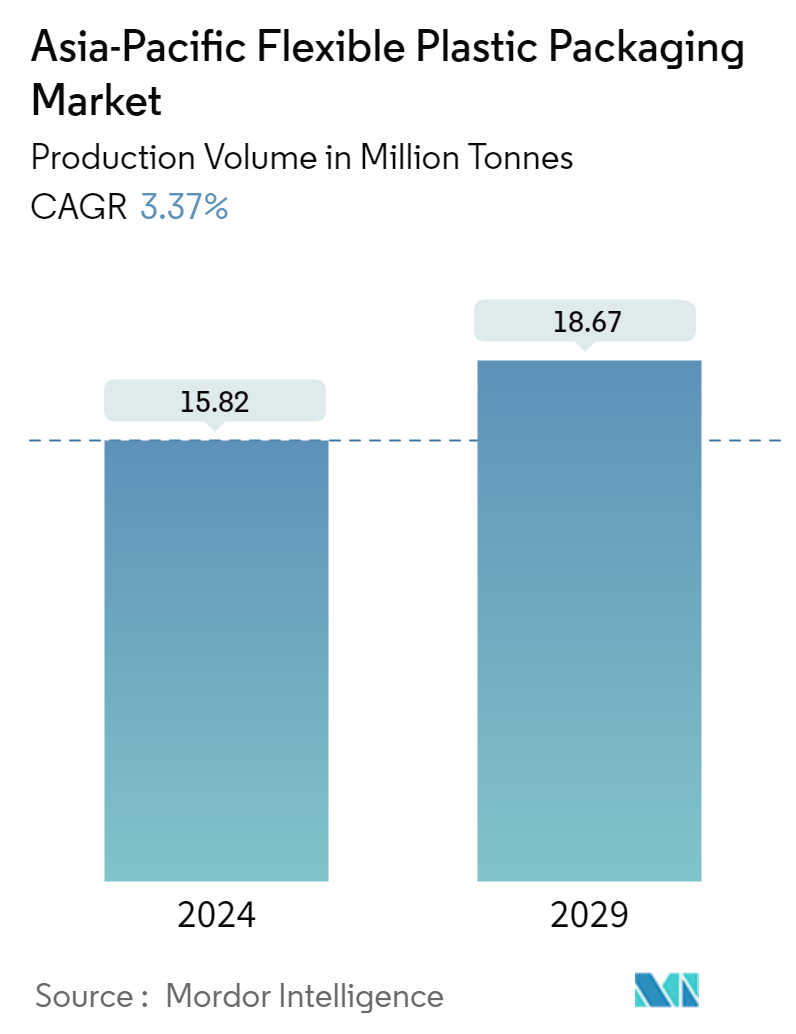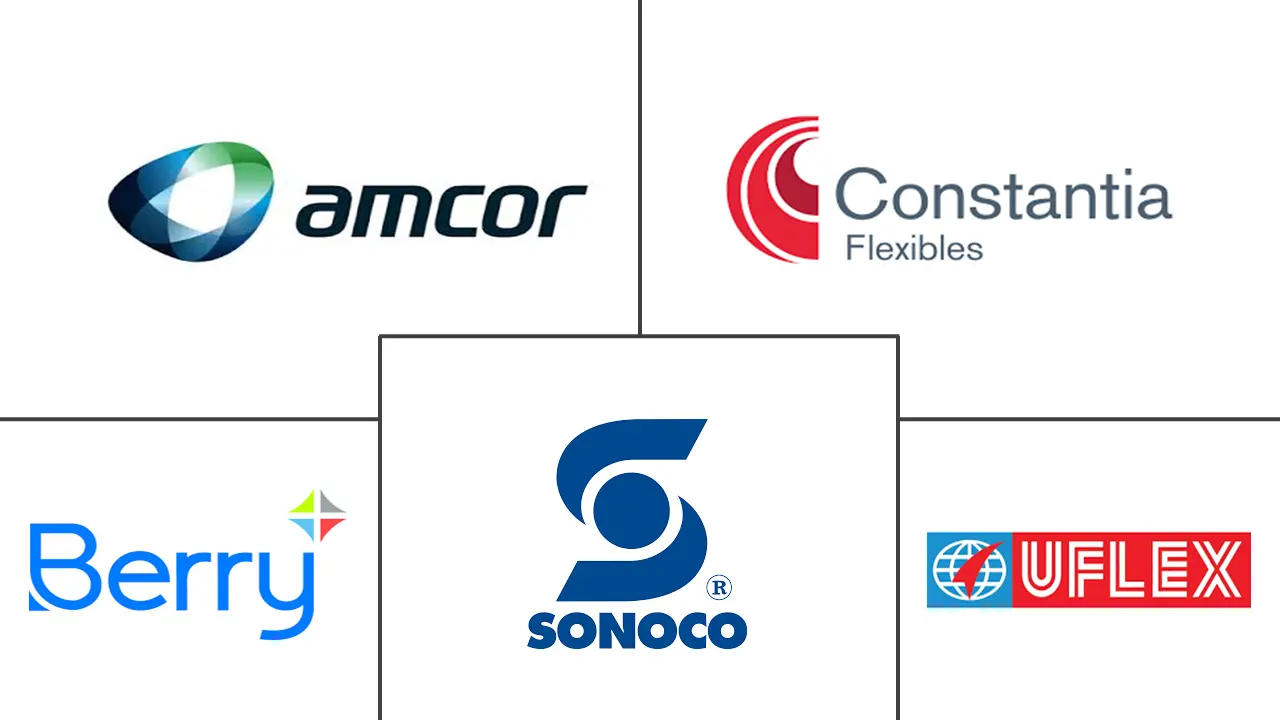Market Size of Asia-Pacific Flexible Plastic Packaging Industry

| Study Period | 2019 - 2029 |
| Base Year For Estimation | 2023 |
| Market Volume (2024) | 15.82 Million tonnes |
| Market Volume (2029) | 18.67 Million tonnes |
| CAGR (2024 - 2029) | 3.37 % |
| Market Concentration | Low |
Major Players
*Disclaimer: Major Players sorted in no particular order |
Asia-Pacific Flexible Plastic Packaging Market Analysis
The Asia-Pacific Flexible Plastic Packaging Market size in terms of production volume is expected to grow from 15.82 Million tonnes in 2024 to 18.67 Million tonnes by 2029, at a CAGR of 3.37% during the forecast period (2024-2029).
The Asia-Pacific flexible plastic packaging market, a pivotal segment in the region's packaging industry, is witnessing dynamic growth. Flexible plastic packaging, encompassing plastic materials, is favored for its lightweight, durable, and cost-effective nature, catering to a diverse product range.
- This surge in demand for flexible plastic packaging in Asia-Pacific is primarily fueled by urbanization, evolving consumer habits, and a rising appetite for convenient and eco-conscious packaging. Notably, environmental sustainability has taken center stage. Heightened awareness of packaging's ecological footprint prompts the region's consumers and regulators to support sustainable solutions.
- Additionally, there's a tangible shift toward recyclable and biodegradable materials in the flexible packaging landscape. Manufacturers are channeling investments into R&D, striving to craft sustainable alternatives that match or exceed the performance of traditional flexible packaging.
- Countries, like China, dominate the flexible plastic packaging market, with a strong presence in food and beverages, cosmetics, and pharmaceuticals. According to a study by Asiapack Ltd, the Chinese packaging supply chain network has the most comprehensive coverage. This intricate yet efficient network ensures that products are manufactured, packaged, and shipped precisely.
- The market is poised for substantial growth, driven by escalating demand for packaged foods and increased private investments. Moreover, bolstered by robust domestic demand and a labor force that offers cost advantages, Asia-Pacific stands out as the premier market for flexible plastic packaging producers. These dynamics collectively set the stage for a promising future for the flexible packaging market.
- The market also faces challenges owing to plastic pollution across the region. According to a study by the South Pole, the rise in plastic pollution across Southeast Asia has spurred regional governments into action. They have rolled out comprehensive National Action Plans, setting ambitious goals to tackle plastic pollution at its source and downstream. These plans encompass strategies like plastic ban, taxes, and the bolstering of waste management infrastructure.
Asia-Pacific Flexible Plastic Packaging Industry Segmentation
The study on the Asia-Pacific flexible plastic packaging market tracks demands in terms of revenue for flexible plastic packaging by material. It tracks the market size for respective end-user types. The estimates for the Asia-Pacific flexible plastic packaging market include costs associated with flexible plastic packaging manufacturing, from raw material procurement to reaching end-user industries. The estimates exclude the cost of the content that is or is to be packed inside the flexible plastic packaging. The scope of the flexible plastic packaging market is limited to B2B demand. Market numbers have been arrived at using bottom-up and top-down approaches for segmentation, and volume has also been considered.
The Asia-Pacific Flexible Plastic Packaging Market Report is Segmented by Material (Polyethene [PE], Bi-Oriented Polypropylene [BOPP], Cast Polypropylene [CPP], Polyvinyl Chloride [PVC], Ethylene Vinyl Alcohol [EVOH], and Other Material Types [Polycarbonate, PHA, PLA, Acrylic, and ABS]), Product Type (Pouches, Bags, Films and Wraps, and Other Product Types), End-User Industry (Food [Frozen Food, Dry Food, Meat, Poultry, and Sea Food, Candy & Confectionery, Pet Food, Dairy Products, Fresh Produce and Other Food (Seasonings & Spices, Spreadables, Sauces, Condiments, etc.)], Beverage, Medical and Pharmaceutical, Personal Care and Household Care, and Other End User Industry [Automotive, Chemical, Agriculture ]), and Country (China, India, Japan, Vietnam, Thailand, Indonesia, Australia and New Zealand, and Rest of Asia-Pacific).The report offers market forecasts and volume (tonnes) for all the above segments.
| By Material Type | |
| Polyethene (PE) | |
| Bi-oriented Polypropylene (BOPP) | |
| Cast Polypropylene (CPP) | |
| Polyvinyl Chloride (PVC) | |
| Ethylene Vinyl Alcohol (EVOH) | |
| Other Material Types (Polycarbonate, PHA, PLA, Acrylic, and ABS) |
| By Product Type | |
| Pouches | |
| Bags | |
| Films and Wraps | |
| Other Product Types (Blister Packs, Liners, etc) |
| By End-User Industry | ||||||||||
| ||||||||||
| Beverage | ||||||||||
| Medical and Pharmaceutical | ||||||||||
| Personal Care and Household Care | ||||||||||
| Other End user Industries ( Automotive, Chemical, Agriculture) |
| By Country*** | |
| China | |
| India | |
| Japan | |
| Vietnam | |
| Thailand | |
| Indonesia | |
| Australia and New Zealand |
Asia-Pacific Flexible Plastic Packaging Market Size Summary
The Asia-Pacific flexible plastic packaging market is experiencing significant growth, driven by factors such as urbanization, changing consumer preferences, and a heightened focus on sustainability. This market segment, integral to the region's packaging industry, benefits from the lightweight, durable, and cost-effective nature of flexible plastic materials. The increasing demand for convenient and eco-friendly packaging solutions is prompting a shift towards recyclable and biodegradable materials. Countries like China are at the forefront, with a robust presence in sectors such as food and beverages, cosmetics, and pharmaceuticals. The market's expansion is further supported by rising disposable incomes, population growth, and the growing need for extended shelf life in packaged goods, particularly in India and China.
Despite the promising growth prospects, the market faces challenges related to plastic pollution, prompting regional governments to implement comprehensive National Action Plans. These plans aim to address plastic pollution through strategies like bans, taxes, and improved waste management infrastructure. The market is also witnessing increased retail penetration and investments, particularly in India, where stringent quality control standards are being enforced. Key players in the market, including Uflex Limited, Sealed Air Corporation, and Amcor PLC, are focusing on strategic collaborations, acquisitions, and product innovations to enhance their market presence. These dynamics, coupled with ongoing technological advancements, set the stage for a promising future for the flexible plastic packaging market in the Asia-Pacific region.
Asia-Pacific Flexible Plastic Packaging Market Size - Table of Contents
-
1. MARKET INSIGHTS
-
1.1 Market Overview
-
1.2 Industry Attractiveness - Porter's Five Forces Analysis
-
1.2.1 Bargaining Power of Suppliers
-
1.2.2 Bargaining Power of Buyers
-
1.2.3 Threat of New Entrants
-
1.2.4 Threat of Substitute Products
-
1.2.5 Intensity of Competitive Rivalry
-
-
1.3 Industry Value Chain Analysis
-
-
2. MARKET SEGMENTATION
-
2.1 By Material Type
-
2.1.1 Polyethene (PE)
-
2.1.2 Bi-oriented Polypropylene (BOPP)
-
2.1.3 Cast Polypropylene (CPP)
-
2.1.4 Polyvinyl Chloride (PVC)
-
2.1.5 Ethylene Vinyl Alcohol (EVOH)
-
2.1.6 Other Material Types (Polycarbonate, PHA, PLA, Acrylic, and ABS)
-
-
2.2 By Product Type
-
2.2.1 Pouches
-
2.2.2 Bags
-
2.2.3 Films and Wraps
-
2.2.4 Other Product Types (Blister Packs, Liners, etc)
-
-
2.3 By End-User Industry
-
2.3.1 Food
-
2.3.1.1 Candy & Confectionery
-
2.3.1.2 Frozen Foods
-
2.3.1.3 Fresh Produce
-
2.3.1.4 Dairy Products
-
2.3.1.5 Dry Foods
-
2.3.1.6 Meat, Poultry, And Seafood
-
2.3.1.7 Pet Food
-
2.3.1.8 Other Food Products (Seasonings & Spices, Spreadables, Sauces, Condiments, etc.)
-
-
2.3.2 Beverage
-
2.3.3 Medical and Pharmaceutical
-
2.3.4 Personal Care and Household Care
-
2.3.5 Other End user Industries ( Automotive, Chemical, Agriculture)
-
-
2.4 By Country***
-
2.4.1 China
-
2.4.2 India
-
2.4.3 Japan
-
2.4.4 Vietnam
-
2.4.5 Thailand
-
2.4.6 Indonesia
-
2.4.7 Australia and New Zealand
-
-
Asia-Pacific Flexible Plastic Packaging Market Size FAQs
How big is the Asia-Pacific Flexible Plastic Packaging Market?
The Asia-Pacific Flexible Plastic Packaging Market size is expected to reach 15.82 million tonnes in 2024 and grow at a CAGR of 3.37% to reach 18.67 million tonnes by 2029.
What is the current Asia-Pacific Flexible Plastic Packaging Market size?
In 2024, the Asia-Pacific Flexible Plastic Packaging Market size is expected to reach 15.82 million tonnes.

